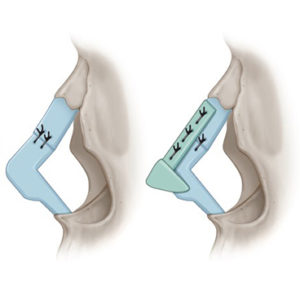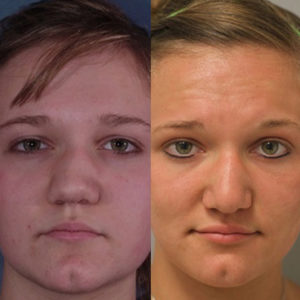Key Points: Synopsis: The over-resected nose or native under-projected nasal dorsum can be augmented with alloplastic or autologous implants, with autologous implants being more preferred due to their safety, biocompatibility and long-term survival. The diced cartilage fascia graft has been the preferred method for dorsal augmentation for several years 1,2, but the diced cartilage glue… [Read More]
Functional & Reconstructive Rhinoplasty
Augmentation Rhinoplasty Using Alloplastic Implants
It is generally agreed that autologous tissue is the material of choice for the rhinoplasty. Alloplastic materials are inherently subject to risks of bacterial infection, extrusion, migration and other problems. However, it is often overly emphasized or exaggerated for the risks of alloplastic materials by experts. Complications from alloplastic implants in rhinoplasty may decrease with… [Read More]
The Surgical Management of the Severe Nasal Saddle Deformity
Introduction Generations of rhinoplasty surgeons have struggled to find a way to correct and consistently manage saddle deformities of the nasal dorsum. These deformities of the nasal framework can lead to devastating emotional and psychological effects in patients1. The more common causes that can lead to the development of these severe dorsal contour irregularities are… [Read More]
How to Manage Deviated Nose: Personal Tips
Abstract Deviated nose is one of the most difficult problems to correct even for experts of rhinoplasty. To correct the deviated nose, preoperative diagnosis and examination are as important as surgical techniques. After precise preoperative examination and planning, proper surgical techniques should be applied according to anatomical location and type of deviation to correct the… [Read More]
The Deviated Nose
Abstract The deviated nose constitutes the most severe and complex deformation of the nasal septum. Deviation of the dorsal portion of the septum not only gives rise both to functional problems and to asymmetry and aesthetic deformity, often with a marked social impact, but also proves one of the most difficult conditions to correct because… [Read More]
Saddle Nose Deformity: Selection of Augmentation Materials and Management
Introduction A saddle nose deformity is characterized by a markedly depressed bony dorsum and an accompanying collapse of the middle nasal vault in relation to the tip and dorsum1. This deformity is the result of a complex interplay of factors leading to the loss of structural support of the nasal septum and upper lateral cartilages,… [Read More]
Saddle Nose
Saddle nose is a clearly visible depression of the nasal dorsum that impairs the aesthetic harmony of the face and proves particularly unattractive in men and in those of Latin or Mediterranean ethnicity in general.This deformity is frequently accompanied by other impairments such as internal nasal valve incompetence, loss of tip support and columellar retraction…. [Read More]
Saddle Nose Deformity
Nasal reconstruction has historically been a challenging art for surgeons. Straddling the realm of aesthetics and anatomic function, rhinoplasties are temperamental procedures and leave little room for error. Of nasal repairs, saddle nose is not uncommon and remains challenging. Resulting from a broad spectrum of etiologies, and presenting with a wide degree of variation and… [Read More]
Surgical Treatment of Nasal Obstruction in Rhinoplasty
Abstract Often, rhinoplasty patients present not just for aesthetic correction, but for improvement of their nasal breathing due to functional abnormalities or problems. Because the aesthetic and functional problems must be addressed together, an understanding of both the internal and external anatomy is essential. In this article, the authors review the differential diagnosis of nasal… [Read More]









